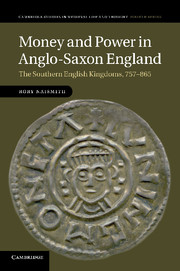Book contents
- Frontmatter
- Contents
- Figures
- Maps
- Tables
- Acknowledgements
- Abbreviations
- Chapter 1 Introduction
- Chapter 2 Money in its political context
- Chapter 3 Looking at coinage: iconography and inscriptions
- Chapter 4 Authority and minting I: the king
- Chapter 5 Authority and minting II: mints, die-cutters and moneyers
- Chapter 6 Value judgements: weight and fineness
- Chapter 7 Production of coinage
- Chapter 8 The circulation of coinage
- Chapter 9 The nature of coin-use in the early Middle Ages
- Chapter 10 Conclusion
- Bibliography
- Index
- References
Chapter 5 - Authority and minting II: mints, die-cutters and moneyers
Published online by Cambridge University Press: 07 October 2011
- Frontmatter
- Contents
- Figures
- Maps
- Tables
- Acknowledgements
- Abbreviations
- Chapter 1 Introduction
- Chapter 2 Money in its political context
- Chapter 3 Looking at coinage: iconography and inscriptions
- Chapter 4 Authority and minting I: the king
- Chapter 5 Authority and minting II: mints, die-cutters and moneyers
- Chapter 6 Value judgements: weight and fineness
- Chapter 7 Production of coinage
- Chapter 8 The circulation of coinage
- Chapter 9 The nature of coin-use in the early Middle Ages
- Chapter 10 Conclusion
- Bibliography
- Index
- References
Summary
Mint-towns
The production of coinage in the eighth and ninth centuries was intimately associated with the basic superstructure of mint-towns. Yet the custom of naming just the king and the moneyer on most issues obscures the exact number and location of minting-places. On one level this emphasizes that, to all intents and purposes, each moneyer was his own mint. However, patterns of political affiliation, typology and die-cutting style among the moneyers indicate that there was a relatively small number of groups into which they can be divided. Five main groups can be distinguished south of the Humber, and these are usually taken to represent five mint-towns: London, Canterbury, Rochester, Ipswich and Southampton or Winchester.
Minting at the first three of these locations is confirmed by occasional episcopal and mint-signed coins. At London these include the issues of Bishop Eadberht in the 770s and 780s, and two famous mint-signed coins from the early ninth century: the Coenwulf mancus and a unique penny produced during Ecgberht’s short spell as king of Mercia. Certain pennies of Ecgberht carry on the reverse an invocation of St Andrew, patron saint of Rochester cathedral, and other pennies of similar style under Ceolwulf I explicitly name the mint: Dorobrebia. The archbishops of Canterbury were named on coins from the 770s onwards, and from c. 805 and after four royal and seven archiepiscopal coin-types were issued which expressly referred to the location of the mint at Dorobernia. The two other recognizable mints in East Anglia and Wessex are never named on coins, nor were they ever the source of episcopal issues. Identification of them rests on careful analysis of coin-circulation and on the wider historical and archaeological context.
- Type
- Chapter
- Information
- Money and Power in Anglo-Saxon EnglandThe Southern English Kingdoms, 757–865, pp. 128 - 155Publisher: Cambridge University PressPrint publication year: 2011
References
- 1
- Cited by



